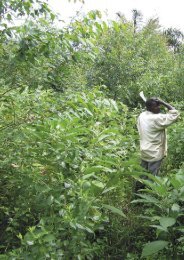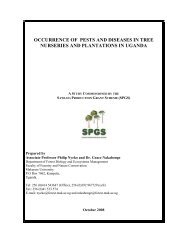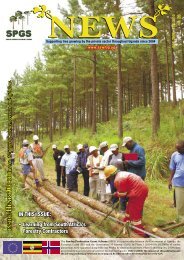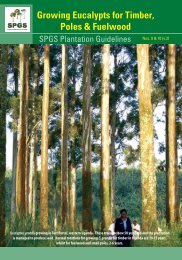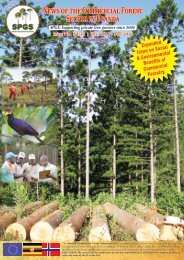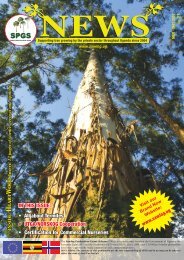COMMUNITY TREE PLANTING GUIDELINE - SPGS
COMMUNITY TREE PLANTING GUIDELINE - SPGS
COMMUNITY TREE PLANTING GUIDELINE - SPGS
You also want an ePaper? Increase the reach of your titles
YUMPU automatically turns print PDFs into web optimized ePapers that Google loves.
LAWLOG PRODUCTION GRANT SCHEME<br />
ii.<br />
iii.<br />
iv.<br />
Establish a firebreak (5-15m) along the boundary<br />
to surround your plantation. If your plantation<br />
is surrounded by food gardens, make sure that<br />
after they are harvested, the drying vegetation is<br />
removed and placed at least 5m away.<br />
Where a clear public road, any permanent water<br />
body or a natural forest borders your plantation,<br />
these should form the firebreak.<br />
Decide on the spacing of your trees - which<br />
among others depends on tree species and<br />
expected final product<br />
For large scale plantations, much more can be done on<br />
the lay out. For example, the plantation area is divided<br />
into sub units or compartments (normally 25-30ha),<br />
which are separated by at least 8-15m wide spaces. The<br />
road network both internal and external is included<br />
which could be 5-8m wide.<br />
3.1.5 How can I determine the<br />
area of my plantation?<br />
You should know the size of your plantation so that<br />
you can estimate the number of seedlings needed for<br />
planting among others. Depending on whether your<br />
area is big or small the methods described below can<br />
serve as a guide.<br />
i. For small community woodlots that are normally<br />
1-2 acres, the area can be estimated by counting<br />
walking steps along two main directions. The<br />
number of steps taken along one corner of the<br />
plot is taken as length and the other as width. A<br />
walking step is approximated to be one metre.<br />
ii.<br />
iii.<br />
iv.<br />
If the area is approximately in the form of a<br />
square or rectangle, a long measuring tape can<br />
be used to measure the two sides of the area.<br />
One side is taken as length and other as width.<br />
Multiplying the two sides gives an approximate<br />
size of the area in square meters (m 2 ). This can<br />
then be converzted into hectares by dividing by<br />
10,000m 2 .<br />
Using Global Positioning System (GPS) which<br />
automatically computes the area in hectares<br />
after moving around the boundary of your<br />
plantation. GPS machines are still rare and thus<br />
the charges for their use may be high. They are<br />
recommended for big areas only.<br />
The district survey departments or private<br />
surveyors near to you can be contracted to<br />
demarcate your land.<br />
3.2 What is the right tree<br />
species to plant on my<br />
area?<br />
You can decide on which tree species to plant on your<br />
area by carrying out species site matching: this is the<br />
procedure undertaken to determine the most suitable<br />
tree species to be planted on a particular area. It is<br />
important that you ONLY plant trees that are most<br />
suited to your area. This is because only the best suited<br />
trees planted on an area will grow fast and mature early.<br />
In other words, the selection of the right tree species<br />
to plant on your area directly determines the success or<br />
failure of your plantation!<br />
3.3 What factors determine the<br />
type of tree species to be<br />
planted?<br />
In most cases, tree growth is affected by climate and<br />
soil conditions of the area. Other factors are the<br />
expected final products (targeted market), the nature<br />
of your land (hilly or flat), pest and disease threat. So,<br />
you can tell which tree species to plant on your area by<br />
looking at the following climate and soil conditions and<br />
comparing them with the various tree species growth<br />
requirements on table 1.<br />
a) Climate mainly rainfall and temperatures:<br />
• Rainfall amount and distribution. Basically areas<br />
that receive two long rainy seasons (at least 3<br />
months) per year are suited for most tree species<br />
like Eucalyptus grandis, Pinus patula, Pinus caribaea,<br />
Maesopsis eminii, Cupressus lusitanica and Araucaria<br />
cunninghamii. Areas that have only one long rain<br />
season per year like in northern Uganda are most<br />
suited for growing Pinus caribaea. Generally, areas<br />
along the cattle corridor like Mbarara, Mubende,<br />
Kiboga, Nakasongola, Teso and Karamoja regions<br />
which are usually dry should at the time being focus<br />
on planting the reasonably drought resistant Pinus<br />
caribaea until other appropriate tree species are<br />
available.<br />
• Temperature. Pinus patula is strictly restricted to<br />
cooler temperatures especially those in Kabale.<br />
If planted else where it will fail. Cool areas like<br />
Kabale, Fort Portal, Paidah, Mbale and Kapchorwa<br />
are preferred by Eucalyptus grandis and Cupressus<br />
lusitanica as well.<br />
<br />
Community Tree Planting Guideline



